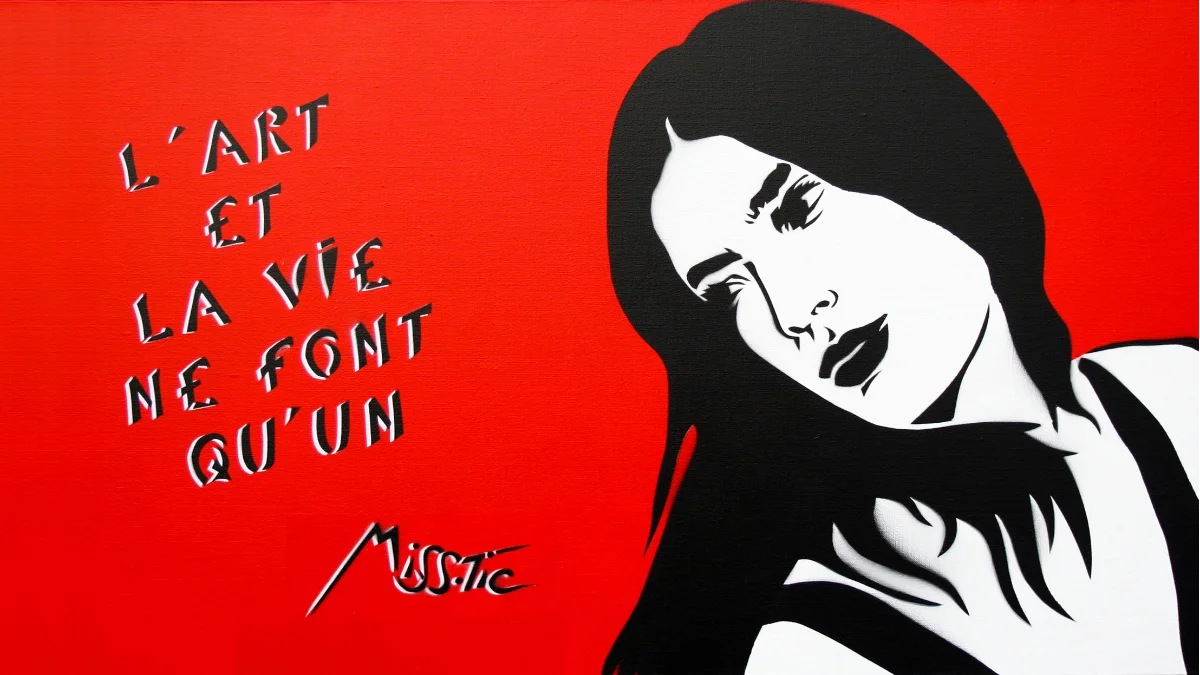Radhia Novat was born in Paris in 1956. She would later adopt the pseudonym Miss.Tic, a reference to a cartoon character. Her work, which began in 1985, involved applying stenciled images to the city's walls, primarily in Paris. These images, almost always silhouettes of women, were paired with short phrases and aphorisms. Her interventions in the public space spanned more than thirty-five years, permanently altering the perception of certain neighborhoods and questioning the status of artwork outside of traditional exhibition venues. Her approach led to legal battles before ultimately culminating in institutional recognition.
Ready to see Paris through the eyes of a French street art legend?
Biographical Sketch
Born in the Montmartre district to a Tunisian immigrant father and a mother from Normandy, Radhia Novat experienced a biographical rupture at the age of ten. A car accident resulted in the deaths of her mother, brother, and grandmother. She spent the rest of her childhood and adolescence in the Parisian suburbs, in Orly, with her father. After high school, she studied applied arts, then turned to street theater, which she practiced with the Zéro de conduite company.
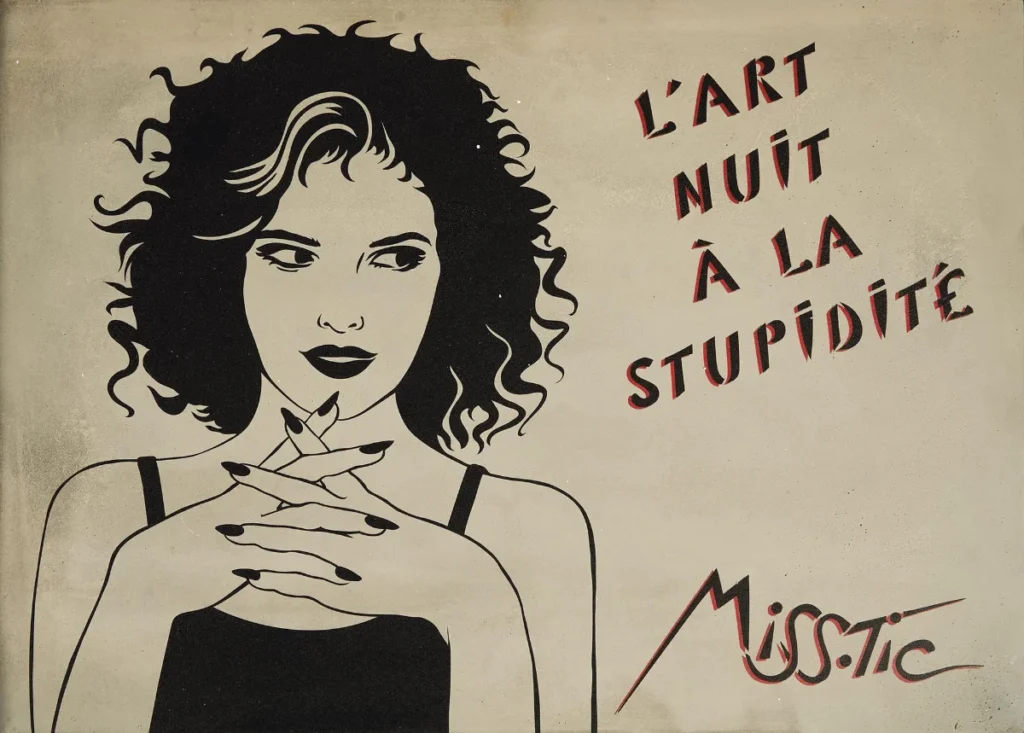
In the early 1980s, a trip to the United States brought her into contact with art scenes whose maturity starkly contrasted with the situation in France at the time. In California, she observed the punk aesthetic that used stencils as a tool for direct and subversive communication. Meanwhile, in New York, artists like Jean-Michel Basquiat and Keith Haring were already transitioning from the street to galleries, blurring the lines between graffiti and the art market. In France at that moment, urban art was still in its infancy and almost universally regarded as vandalism. Stencil pioneers like Blek le Rat, who began painting his rats in Paris in 1981, operated in complete clandestinity. It was in this context that Miss.Tic, influenced by the American effervescence but also by the first Parisian stencil artists, decided to leave theater behind to take over the public space. In 1985, she created her first mural, importing not just a technique, but also the idea that the street could be a stage. This approach foreshadowed a radical paradigm shift: today, street art is not only institutionalized but also fuels a highly speculative secondary market where works by artists like Banksy and Kaws break records at major auction houses. Miss.Tic’s own journey, from conviction to collection, embodies this trajectory.
Her work developed continuously. She roamed the city, scouting walls, doors, and fences. Her materials were simple: stencils she cut herself from cardboard or rhodoid plastic, and cans of spray paint. The technique allowed for quick execution, a necessary condition for a practice that was then illegal.
The Method: Image and Text
Miss.Tic's method was based on the association of two elements: an image and a text. The image was almost invariably that of a woman. The first models were stylized self-portraits. The silhouette is black, the features are clean, and the posture is often suggestive or self-assured. This woman is an archetypal figure who embodies a voice.
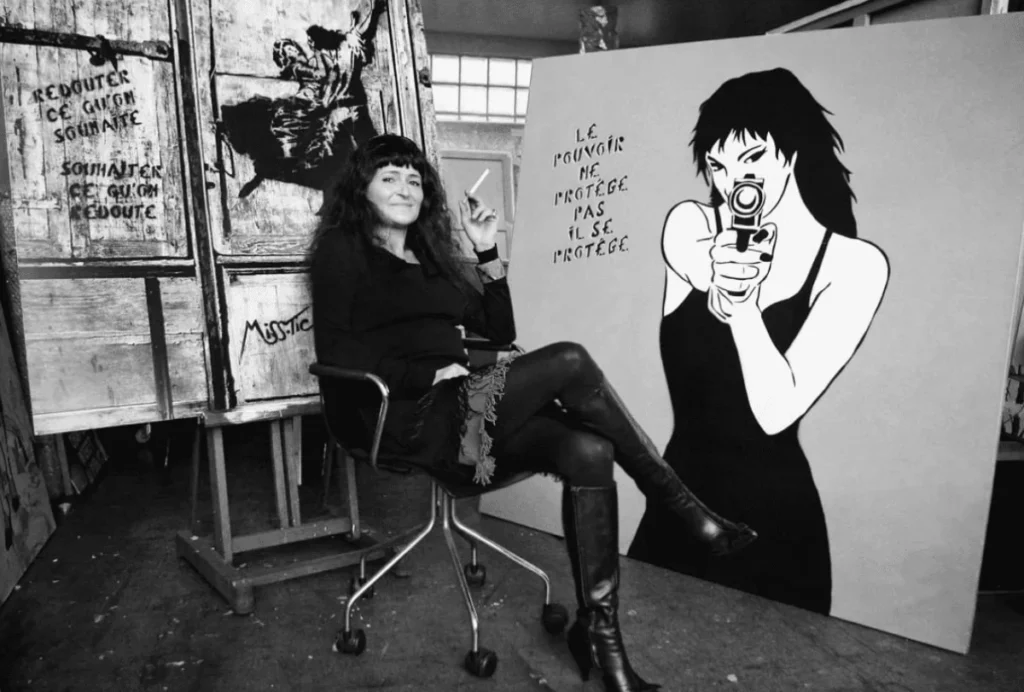
The accompanying text is not a caption. It is a brief statement, built on wordplay, twists on common expressions, or aphorisms. The phrases explore themes of desire, love, art, freedom, and the female condition. Language is used for its polysemy, its double meanings. The artist explained her approach with the formula: "I put words to life's woes." The interaction between the drawing and the phrase produces the meaning. The image gives a face to the words, the text gives a voice to the image.
The stencil is not just a tool; it is at the heart of the process. It allows for the reproducibility of the motif. The same silhouette can thus reappear in different places, creating a serial effect and establishing a familiar presence in the urban landscape. This repetition is a central element of her artistic signature. It makes her work immediately identifiable to passersby. Each intervention is signed "Miss.Tic," distinguishing her from the anonymity often associated with graffiti.
Intervening in the City
Miss.Tic used Paris as a defined territory for intervention, not just as a simple canvas. Her works are not scattered randomly but are concentrated in neighborhoods whose sociology and history resonate with her approach. She anchored her practice in the 13th arrondissement, setting up her permanent studio in the heart of the Butte-aux-Cailles. This neighborhood, an old village annexed late into the capital, has retained a working-class identity and a mixed social fabric of artisans, laborers, and an artist population. By working there daily, Miss.Tic engaged in a close dialogue with the residents, far from the institutional art circuits. Her interventions extended to other areas marked by a strong historical and social identity. Montmartre and Ménilmontant, popular strongholds and havens for artists since the 19th century, offered her walls steeped in history. The Marais was another significant hub of intervention. Beyond its aristocratic past, the neighborhood in the 1980s and 1990s was a place of profound social change: it was simultaneously the heart of the historic Jewish quarter, a center for craftsmanship, a gathering place for the gay community, and an area undergoing gentrification. By choosing these territories, Miss.Tic was not just selecting a surface; she was addressing diverse audiences and embedding her female figures and aphorisms in contexts of life, memory, and social transformation. The choice of location was also pragmatic, guided by visibility, the nature of the surface—an old wall offering a better grip than a smooth one—and the history of the place.
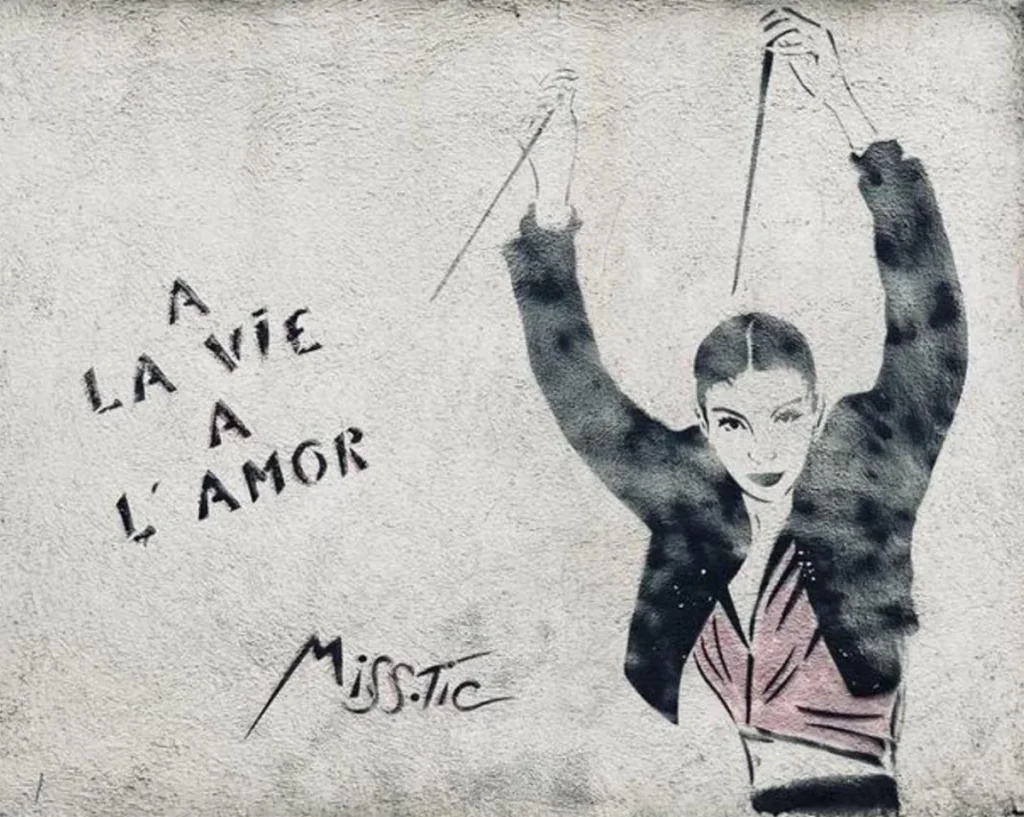
The reception of her works by the inhabitants of the neighborhoods she chose was a decisive factor in the longevity of her work. While the initial interventions may have been met with indifference or seen as defacement, a relationship of familiarity and attachment gradually formed. Numerous accounts, particularly reported in the local press after her death, speak of a real dialogue between the artist and the residents. It was not uncommon for property owners, initially neutral or hostile, to end up protecting the works, for instance by asking building painters to work around them during renovations. In a May 2022 article in Le Parisien, a resident of the Butte-aux-Cailles described her as "the neighborhood's poet," stressing that her stencils were "part of the scenery." This appropriation by the populace transformed her illegal interventions into local heritage, long before any official recognition. Shopkeepers even asked her to put her signature on their storefronts, inverting the logic of complaint into one of reclamation.
Her work is inscribed on the skin of the city. Crumbling walls, carriage doors, and mailboxes become surfaces for the art. The appearance of her stencils changes the perception of these places. A daily commute could be punctuated by the discovery of a new work or the rereading of an old one. The passerby becomes an unintentional spectator. The work is not sought out in a museum; it presents itself unexpectedly.
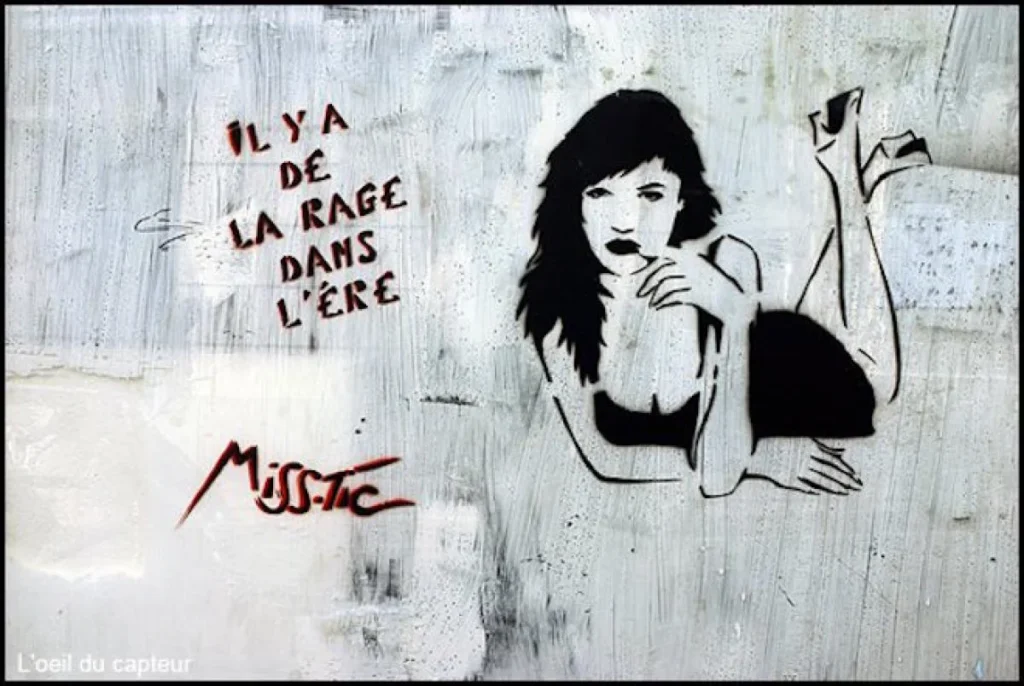
This practice establishes a poetics of urban space. It does not consist of beautifying the city in a decorative sense, but of inserting points of rupture, moments of questioning. The wall is no longer a simple architectural boundary; it becomes a space for speech. The artist activates inert places by leaving a human trace, a thought, a figure. This form of public art is based on surprise and familiarity. The surprise of the first encounter, then the familiarity that sets in with repeated viewings and new appearances. Her works, subject to the ravages of time and man, have a precarious existence, although some have been protected or restored by residents.
From Vandalism to Recognition
Miss.Tic's practice of painting on property without authorization is, by definition, illegal. For years, her work was tolerated. In the late 1990s, the situation changed. Property owners and public companies, notably the RATP (Parisian public transport authority), initiated legal proceedings against her. In 1997, she was caught in the act. A trial took place in 2000, at the end of which she was convicted of "defacement of property by inscription, sign, or drawing." The sentence was a significant fine.
This legal episode marked a turning point. It received significant media coverage that shifted the debate from a purely legal question to one about the definition of art. The national press seized on the affair. Dailies like Le Monde and Libération published articles that, beyond the court report, questioned the status of these urban interventions. Television reports, especially on regional France 3 channels, showed the artist explaining her approach. Cultural magazines like Télérama analyzed the phenomenon, helping to forge an image of a committed artist rather than a mere delinquent. This media exposure gave Miss.Tic a platform. In her defense, she argued that she did not deface but "enhanced" the walls, offering a poetic added value to often-neglected surfaces. She championed the significance of her act, defining it as an artistic gesture and not as vandalism, a position that gained legitimacy thanks to this public echo.
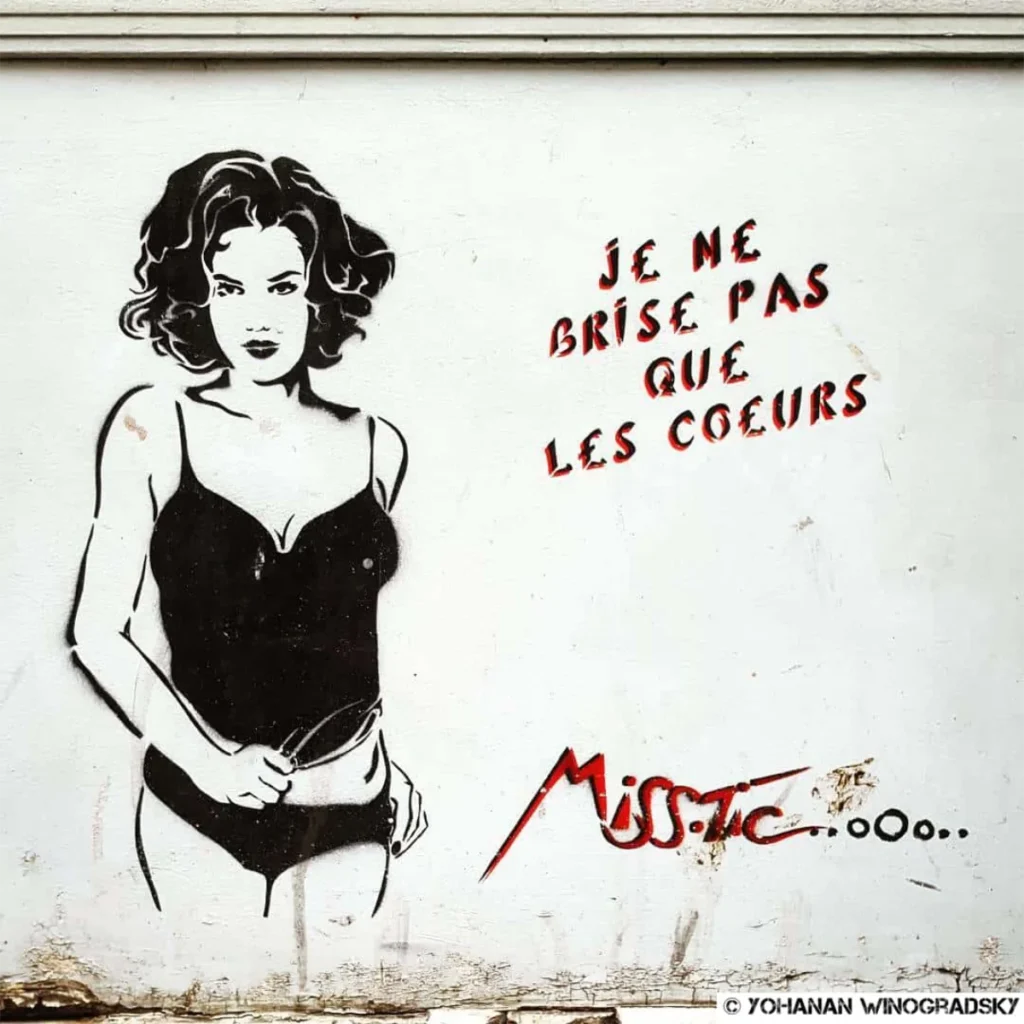
Paradoxically, this conviction coincided with the beginning of institutional recognition. Luxury brands like Louis Vuitton and Kenzo, and designers like Paul Smith, began to commission her. The art world started to take an interest in her work. She exhibited in galleries, and her works on canvas and metal entered the art market. Public commissions followed. In 2007, the city hall of the 5th arrondissement commissioned her to create a mural on a wall in Place Stravinsky. In 2011, the French postal service, La Poste, issued a series of stamps for International Women's Day, illustrated with her stencils.
This trajectory illustrates the evolution of street art's status in France. From a marginal and illegal practice, it has become a recognized art form, integrated into public collections. Works by Miss.Tic have been acquired by the Municipal Contemporary Art Fund of the City of Paris and the Victoria and Albert Museum in London. Radhia Novat passed away in May 2022. Her work remains visible on many of the capital's walls.
Walking with Miss.Tic: 4 Tours to Discover Her Poetic Paris
For the American traveler looking to experience the real Paris, street art offers a unique window into the city's soul. Miss.Tic, a pioneer of urban art, turned the capital into her personal canvas. Her stencils—sharp, poetic, and quintessentially Parisian—are best discovered on foot. Here are four walking tours designed to trace her steps through the neighborhoods she called home.
(Note: While many of Miss.Tic's works have faded or been covered over time, these walks take you through the areas where her presence was strongest. Keep your eyes peeled—you might still find a ghost of a stencil on a weathered wall.)
1. The 13th Arrondissement: The Artist's Home Turf in La Butte-aux-Cailles
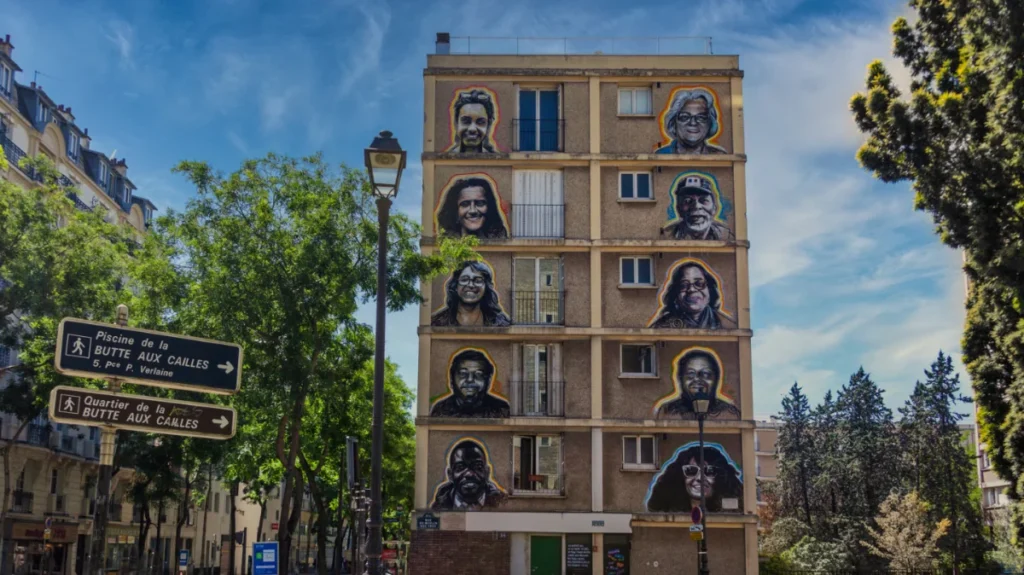
The Vibe: Imagine a small, cobblestoned village hidden in plain sight, with a fiercely independent and artistic spirit. That’s La Butte-aux-Cailles. This was Miss.Tic’s sanctuary, where she lived, worked, and left her most personal marks. It’s less like a museum and more like walking through her own backyard.
The Itinerary:
Start at Métro Corvisart. Your goal is to get lost in the triangle formed by Rue des Cinq Diamants, Rue de la Butte aux Cailles, and Boulevard Auguste Blanqui.
- Rue des Cinq Diamants: This street and its tiny offshoots were her favorite playground. The low-rise buildings and old-fashioned storefronts were perfect canvases.
- Passage Boiton and Villa Daviel: Wander through these charming, almost secret passages. The quiet, residential feel made her poetic statements feel like intimate secrets shared with the neighborhood.
- Her Studio (near Rue de l'Espérance): While her studio is now a private residence, walking around this area allows you to feel the atmosphere that fueled her daily creativity. She was a true local figure here, and residents often protected her work.
What to Look For: This neighborhood is where her art feels most integrated. Look for faded silhouettes on mailboxes, corner walls, and the metal shutters of shops. The themes here are often introspective and deeply tied to the idea of home, belonging, and neighborhood life.
Local Tip: After your walk, grab a drink at Le Temps des Cerises, a historic, cooperatively-owned bistro on Rue de la Butte aux Cailles, embodying the neighborhood's rebellious, community-focused spirit.
2. Le Marais (3rd & 4th Arr.): Chic History Meets Urban Poetry
The Vibe: Historic, aristocratic, and effortlessly cool. Le Marais is where 17th-century mansions meet cutting-edge fashion boutiques and a vibrant LGBTQ+ community. For Miss.Tic, intervening here meant placing her modern female figures in dialogue with centuries of history and social change.
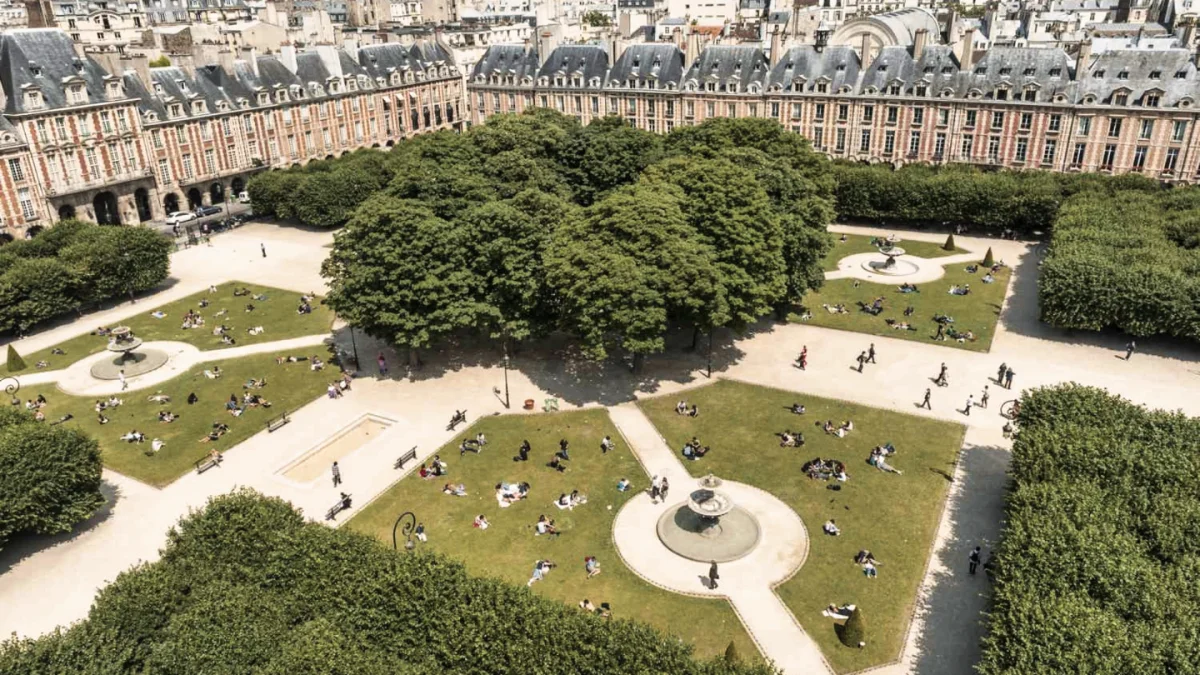
The Itinerary:
Begin at Métro Saint-Paul.
- Rue des Rosiers: The historic heart of the Jewish quarter. Placing her art here was a powerful act of layering modern identity onto a street saturated with memory.
- Rue Vieille du Temple & Rue des Francs-Bourgeois: These are the main arteries of the trendy Marais. Her stencils here often had a sharper, more ironic edge, commenting on desire, fashion, and the performance of self in a very public-facing area.
- Place des Vosges: While she wouldn't have worked on the pristine arches of the square itself, explore the streets radiating from it. Her work would pop up on a weathered door or a construction barrier, creating a stark contrast with the surrounding formal elegance.
What to Look For: Her interventions in Le Marais were often more audacious. She played with the neighborhood's reputation for romance and style, using her aphorisms to deconstruct clichés about love and femininity against a backdrop of historic beauty.
Local Tip: Visit the Marché des Enfants Rouges, Paris's oldest covered market, for a fantastic, diverse lunch. It's a bustling, authentic spot just a short walk from the main Marais streets.
3. Ménilmontant & Belleville (20th Arr.): Gritty, Artistic, and Revolutionary Soul
The Vibe: This is the gritty, beating heart of artistic, multicultural Paris. With its steep hills, hidden courtyards, and revolutionary history (it was a center of the Paris Commune), Ménilmontant offered a raw, politically charged canvas that resonated with Miss.Tic's rebellious spirit.
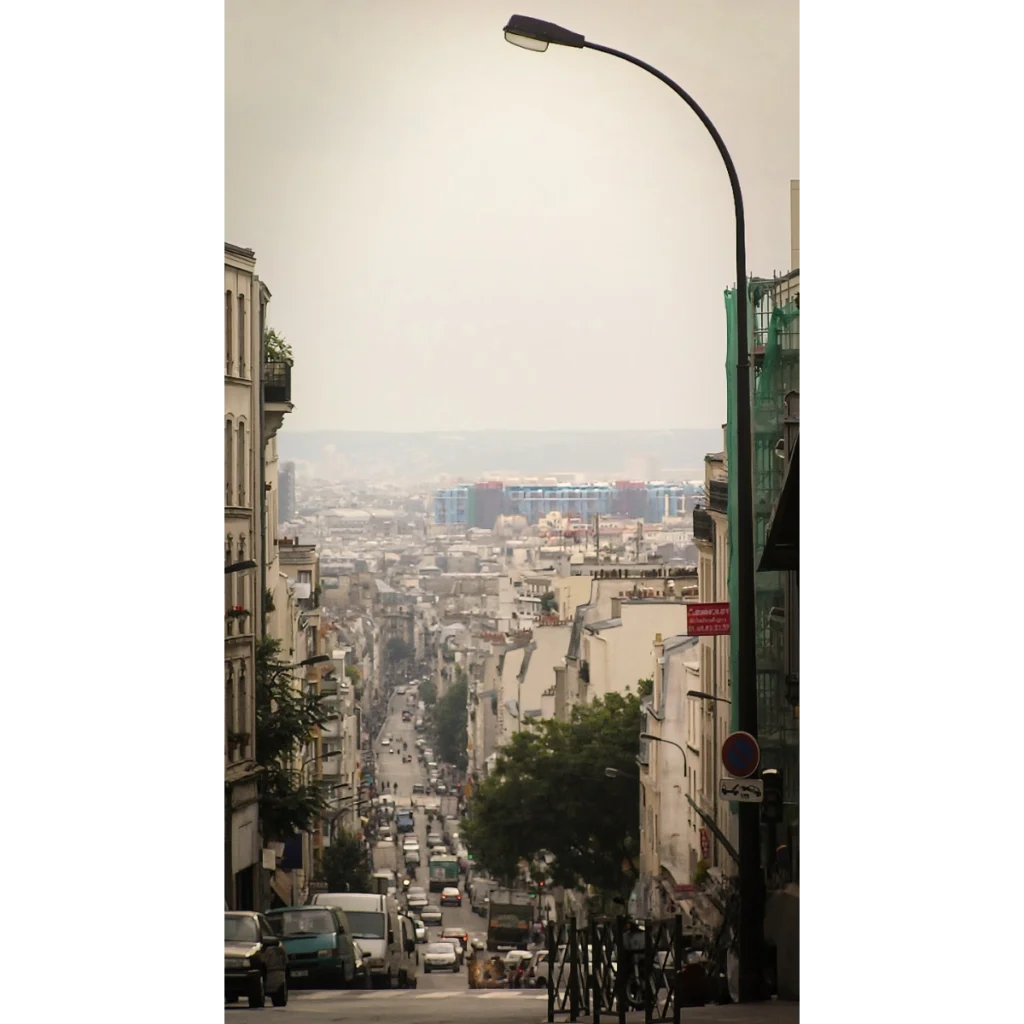
The Itinerary:
Start at Métro Ménilmontant.
- Rue de Ménilmontant: Walk up this long, sloping street. It’s a cross-section of the neighborhood's diverse life and was a prime location for her work.
- Parc de Belleville: Head towards the park. The surrounding streets, like Rue Piat and Rue des Envierges, are famous for street art. Here, her work was part of a larger conversation with other urban artists.
- Rue Denoyez: Though this famous street art alley is constantly changing, it captures the raw energy of the area. Miss.Tic’s presence here connected her to the most dynamic currents of Parisian street art.
What to Look For: Her work in this area often felt more social and political. The women she stenciled here seemed to echo the neighborhood's history of defiance and independence. It was a perfect fit for her feminist and anti-establishment undertones.
Local Tip: End your tour with a mint tea and pastries at a café near the Belleville mosque, or catch a concert at La Bellevilloise, a cultural hub that embodies the area's creative energy.
4. The 14th Arrondissement: Montparnasse's Bohemian Ghost
The Vibe: While the 13th was her home, the 14th was a historical touchstone. The Montparnasse area is legendary for being the hub of artistic and intellectual life in the early 20th century (think Picasso, Hemingway). Miss.Tic tapped into this bohemian ghost, adding her own chapter to its creative history.
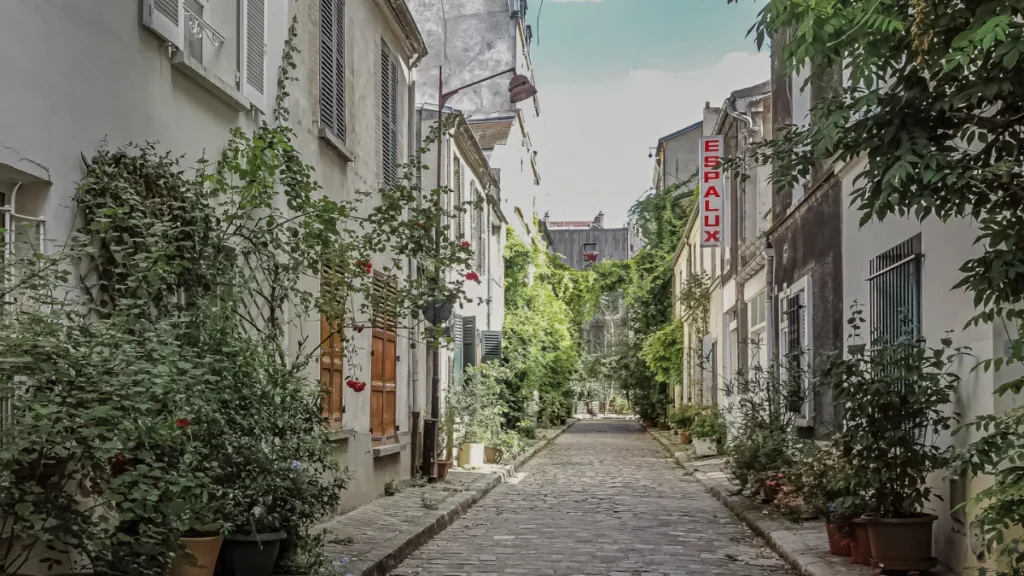
The Itinerary:
Start at Métro Vavin.
- Rue Daguerre: This lively, pedestrianized market street was a key location for her. Its village-like feel and connection to artists (filmmaker Agnès Varda lived here) made it an ideal spot for her intimate, thought-provoking art.
- Around Montparnasse Cemetery: The quiet, slightly melancholic streets surrounding the cemetery were another favored canvas. Her aphorisms on life, love, and time took on a special resonance here.
- Rue de la Gaîté: Historically known for its many theaters, this street offered a perfect backdrop for her work, which often had a theatrical, performative quality.
What to Look For: Her interventions in the 14th often felt like a nod to the area's artistic past. The women she depicted here could be seen as modern muses, continuing the legacy of creative independence that defines Montparnasse.
Local Tip: Have a coffee at Le Dôme or La Rotonde, legendary brasseries on Boulevard du Montparnasse. While touristy, sitting there allows you to soak in the history and imagine Miss.Tic adding her contemporary voice to the neighborhood's artistic dialogue.
Read more :
✔︎ Yayoi Kusama: The Polka Dot Conqueror
✔︎ Tina Modotti: From Factory Worker to Revolutionary Photographer
✔︎ Nan Goldin and the Ballad of Modern Photography
✔︎ Yoko Ono’s Avant-Garde Journey: From Fluxus Pioneer to Art Icon
✔︎ Ana Mendieta: When Art Becomes a Healing Ritual
bonuses : 10 capsules, additional notes
Unlock exclusive content as a freemium or premium subscriber

